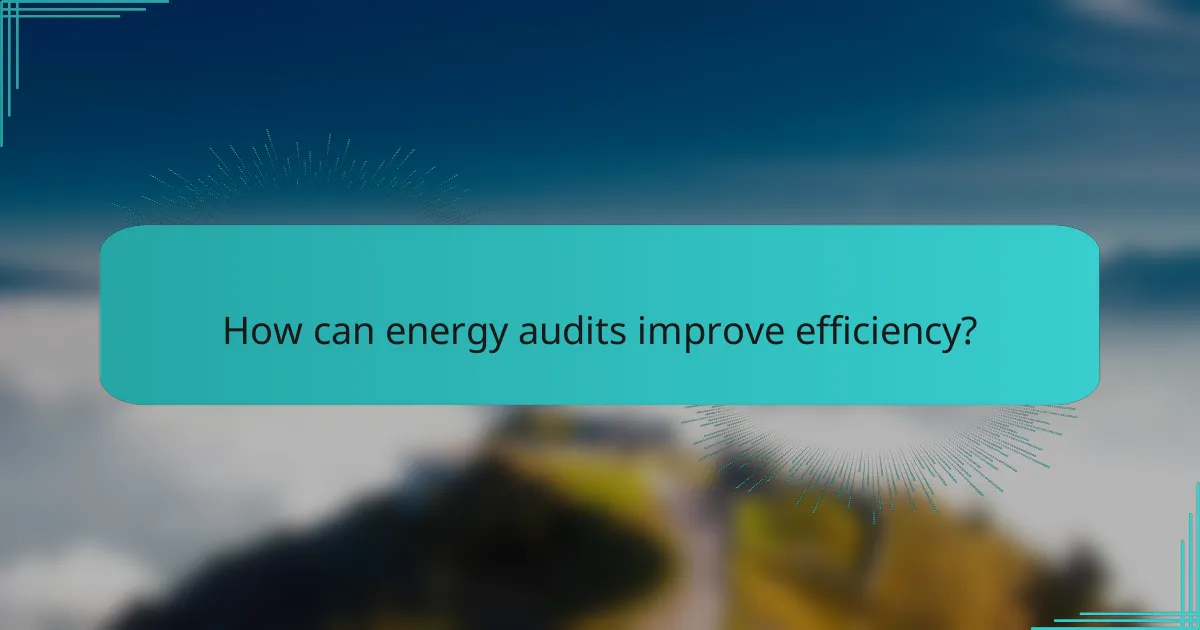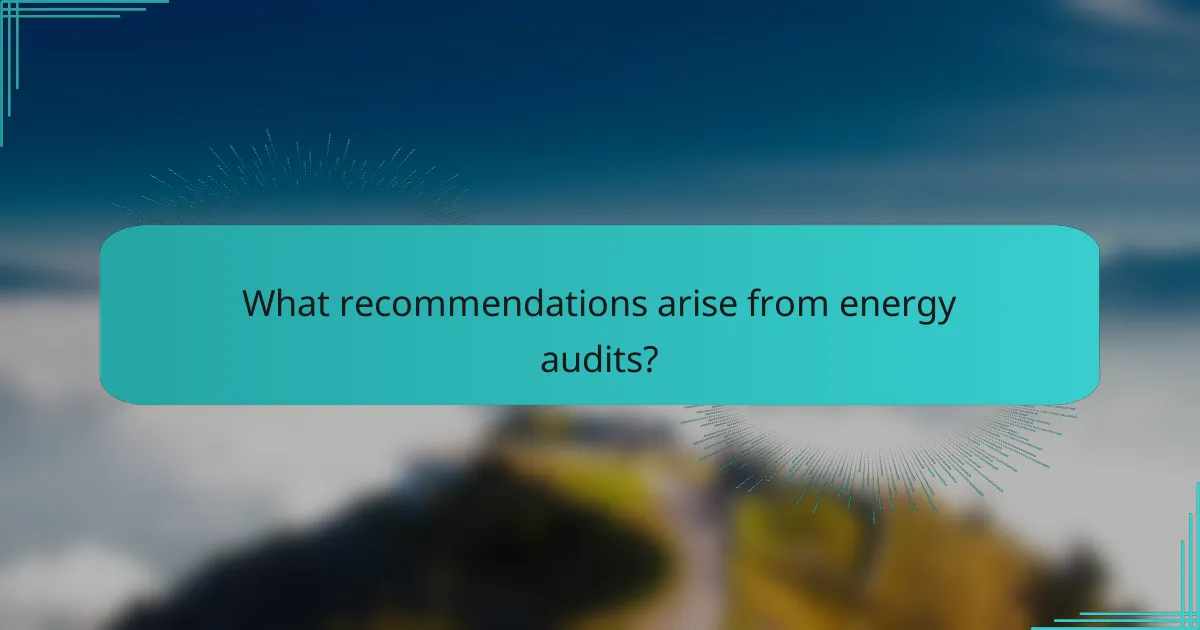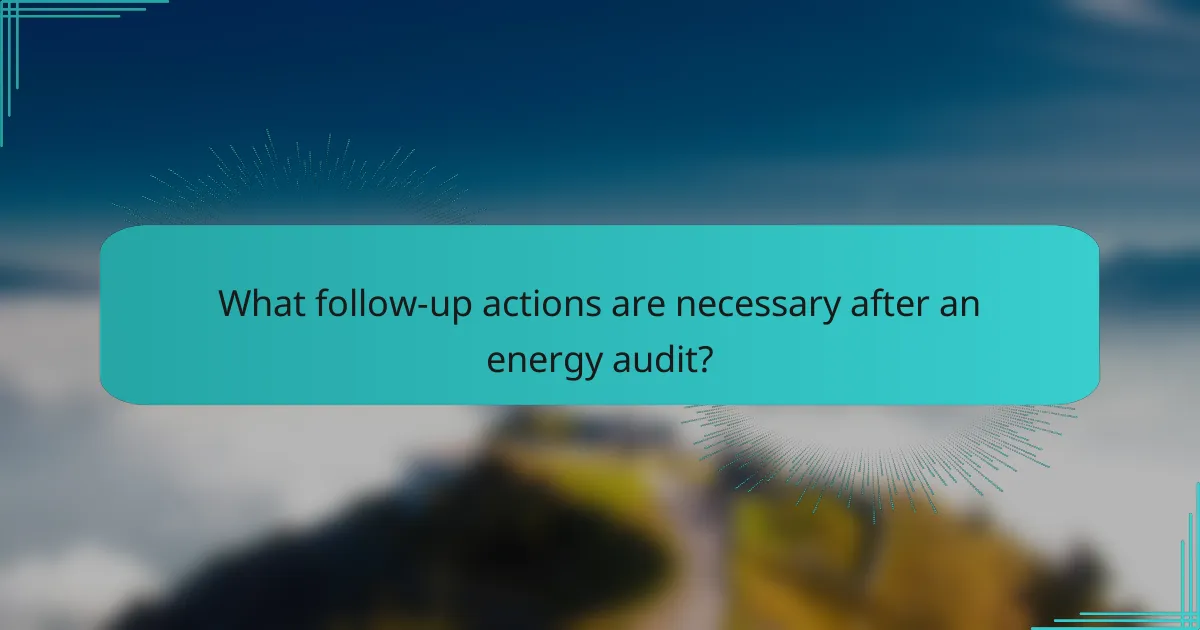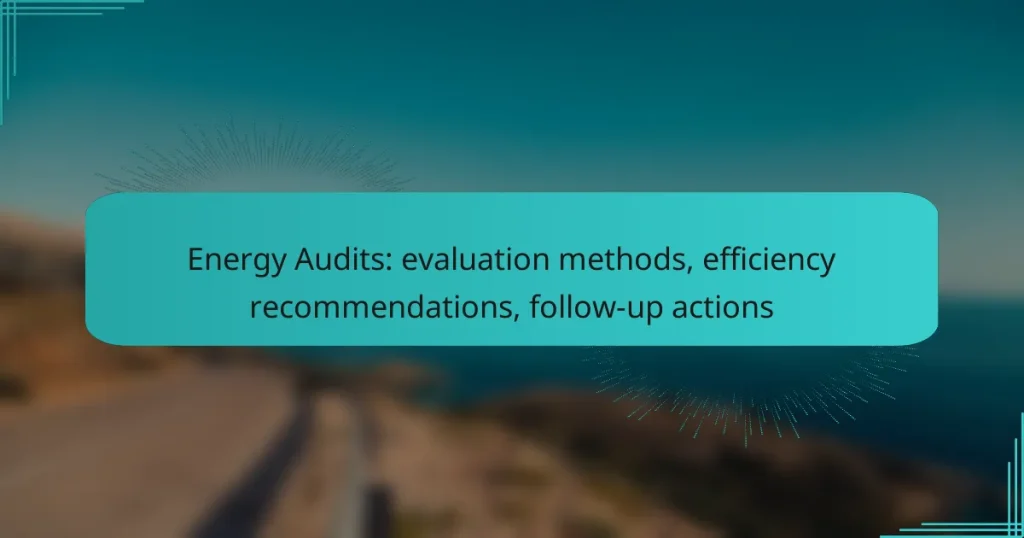Energy audits are essential evaluations that assess energy use and efficiency through methods such as visual inspections and data analysis. By identifying areas of energy waste, these audits provide actionable recommendations to enhance efficiency and reduce costs. Following up on these recommendations can lead to significant improvements in energy performance and overall organizational effectiveness.

What are the energy audit methods in Australia?
Energy audit methods in Australia typically include a combination of visual inspections, data analysis, and specialized tools to assess energy use and efficiency. These methods help identify opportunities for reducing energy consumption and improving overall efficiency in various settings.
Walkthrough assessments
Walkthrough assessments involve a physical inspection of a facility to identify energy-saving opportunities. An auditor reviews lighting, HVAC systems, insulation, and equipment during this process. This method is often the first step in an energy audit, providing a general overview of potential improvements.
During a walkthrough, auditors may take notes on equipment conditions and operational practices. It’s essential to engage staff for insights on energy usage patterns, as their input can highlight issues not immediately visible.
Data analysis techniques
Data analysis techniques utilize historical energy consumption data to identify trends and anomalies. This method often involves comparing current usage against benchmarks or standards, allowing auditors to pinpoint inefficiencies. Tools like energy management software can facilitate this analysis.
Common data points include monthly utility bills and operational hours of equipment. By analyzing this data, auditors can recommend targeted improvements, such as upgrading to energy-efficient appliances or adjusting operational schedules.
Thermal imaging inspections
Thermal imaging inspections use infrared cameras to detect heat loss and inefficiencies in buildings. This method reveals temperature variations that indicate insulation problems, air leaks, or faulty equipment. It is particularly useful for identifying issues that are not visible to the naked eye.
Auditors can conduct thermal imaging inspections during different seasons to assess heating and cooling performance. This technique can help prioritize repairs or upgrades based on the severity of the identified issues.
Utility bill analysis
Utility bill analysis involves reviewing past energy bills to understand consumption patterns and costs. This method helps identify spikes in usage that may indicate inefficiencies or equipment malfunctions. By analyzing these bills, auditors can suggest strategies for cost reduction.
Auditors often look for trends over time, such as seasonal variations in energy use. This analysis can also help forecast future energy costs and assess the financial impact of proposed efficiency measures.
On-site measurements
On-site measurements involve using tools to collect real-time data on energy consumption and performance. This can include measuring power usage of specific equipment or assessing airflow in HVAC systems. These measurements provide precise insights into how energy is being used.
Common tools for on-site measurements include power meters and anemometers. Accurate measurements can help validate findings from other audit methods and support recommendations for energy-saving upgrades.

How can energy audits improve efficiency?
Energy audits can significantly enhance efficiency by identifying areas of energy waste and providing actionable recommendations for improvement. These assessments help organizations optimize their energy usage, leading to better performance and cost savings.
Identifying energy waste
Energy audits systematically evaluate a building’s energy consumption to pinpoint inefficiencies. Common areas of energy waste include outdated lighting, poorly insulated walls, and inefficient HVAC systems. By conducting a thorough analysis, auditors can highlight specific sources of waste and suggest targeted interventions.
Utilizing tools like thermal imaging and energy monitoring systems can provide insights into energy loss. Regular audits can help track improvements over time and ensure that energy-saving measures remain effective.
Enhancing building performance
Improving building performance involves optimizing systems for better energy efficiency and occupant comfort. Energy audits assess not only energy consumption but also the overall functionality of building systems, such as heating, cooling, and ventilation. Recommendations may include upgrading to energy-efficient appliances or improving insulation.
Implementing these recommendations can lead to a more comfortable environment for occupants while reducing energy demands. For instance, switching to LED lighting can enhance illumination quality and reduce energy use by a significant margin.
Reducing operational costs
By addressing energy inefficiencies, organizations can achieve substantial reductions in operational costs. Energy audits provide a roadmap for investments that yield long-term savings, often recouping costs within a few years. For example, upgrading HVAC systems may require an initial investment but can lower energy bills by 20-30%.
Additionally, many regions offer incentives or rebates for energy-efficient upgrades, further reducing the financial burden. Organizations should consider these opportunities when planning energy improvements to maximize their return on investment.

What recommendations arise from energy audits?
Energy audits typically lead to several key recommendations aimed at improving efficiency and reducing costs. These recommendations focus on upgrading systems and technologies to enhance energy performance and minimize waste.
Upgrading insulation
Upgrading insulation is a crucial recommendation from energy audits, as it helps to reduce heat loss in winter and heat gain in summer. Proper insulation can lead to significant energy savings, often ranging from 10% to 30% on heating and cooling costs.
When considering insulation upgrades, focus on areas like attics, walls, and basements. Materials such as fiberglass, foam board, or spray foam can be effective, but ensure they meet local building codes and energy efficiency standards.
Implementing smart technologies
Implementing smart technologies can greatly enhance energy efficiency by automating and optimizing energy use. Smart thermostats, for example, can adjust heating and cooling based on occupancy patterns, potentially saving 10% to 15% on energy bills.
Consider integrating smart lighting systems that adjust based on natural light levels or occupancy. These technologies not only improve convenience but also contribute to overall energy savings and can often be controlled remotely via smartphone apps.
Optimizing HVAC systems
Optimizing HVAC systems is essential for maintaining comfort while minimizing energy consumption. Regular maintenance, including filter changes and system checks, can improve efficiency by 5% to 15%.
Consider upgrading to high-efficiency units or adding zoning systems to control temperatures in different areas of a building. Ensure that your HVAC system is properly sized for your space, as oversized systems can lead to inefficiencies and increased energy use.
Switching to LED lighting
Switching to LED lighting is a straightforward recommendation that can lead to substantial energy savings. LEDs use up to 80% less energy than traditional incandescent bulbs and have a much longer lifespan, often lasting up to 25,000 hours.
When replacing lighting, consider the brightness and color temperature that best suits your space. Although the initial cost may be higher, the long-term savings on energy bills and replacement costs make LEDs a wise investment.

What follow-up actions are necessary after an energy audit?
After an energy audit, necessary follow-up actions include implementing the recommended changes, monitoring energy usage, and scheduling regular audits. These steps ensure that the insights gained from the audit translate into tangible energy savings and efficiency improvements.
Implementing recommended changes
Implementing recommended changes is crucial for realizing energy savings. Start by prioritizing the suggestions based on potential savings and cost-effectiveness. For example, upgrading to energy-efficient lighting or improving insulation can lead to significant reductions in energy consumption.
Consider creating a timeline for these changes, allocating resources, and assigning responsibilities to ensure accountability. Engaging with contractors or specialists may be necessary for more complex upgrades, so budget accordingly.
Monitoring energy usage
Monitoring energy usage helps track the effectiveness of the implemented changes. Utilize energy management systems or smart meters to gather data on consumption patterns. Regularly reviewing this data can highlight areas needing further improvement or adjustment.
Establish benchmarks based on pre-audit energy usage to measure progress. Aim for a consistent review schedule, such as monthly or quarterly, to stay informed and make timely decisions.
Scheduling regular audits
Scheduling regular audits is essential for maintaining energy efficiency over time. Aim for annual audits or bi-annual assessments to ensure that energy-saving measures remain effective and to identify new opportunities for improvement.
Consider engaging the same auditor for consistency and familiarity with your facility. Additionally, keep abreast of changes in energy regulations or technologies, as these can influence your energy strategy and potential savings.


